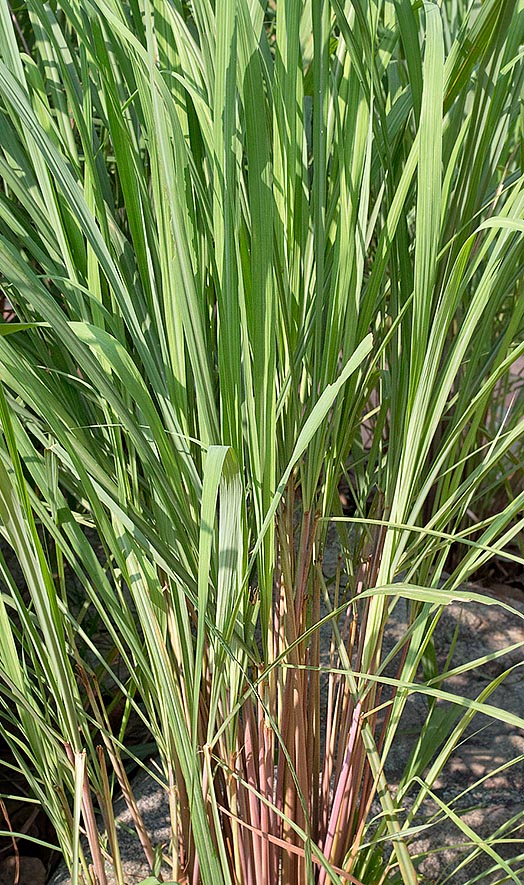Family : Poaceae

Text © Pietro Puccio

English translation by Mario Beltramini

Decorative and medicinal, Citronella (Cymbopogon nardus) sends away mosquitoes © Mazza
The species is native to Africa (Angola, Botswana, Burundi, Democratic Republic of the Congo, Kenya, Lesotho, Madagascar, Mozambique, Ruanda, Seychelles, South Africa, Sudan, Swaziland, Tanzania, Uganda and Zimbabwe) and tropical Asia (Assam, Bangladesh, Bhutan, Cambodia, India, Laos, Myanmar, Sri Lanka and Vietnam), where it grows in the uncultivated spaces, in the deciduous thickets, in the prairies and along the roads, even on poor soils.
The name of the genus is the combination of the Greek terms “kymbe” = boat and “pogon” = beard, with reference, after some, to the concave foliar sheath that subtends the villous inflorescence; the name of the species is the Latin term “nardus” = nard, name given to various odorous plants.
Common names: Ceylon citronella, citronella grass, geranium grass, mana grass, nard grass, nardus grass (English); citronelle, citronnelle de Ceylan (French); citronella (Italian); citronela de Ceilan, citronela do Ceilão (Portuguese); citronela, zacate limón (Spanish); Ceyloncitronell, Zitronellgras, Nardusgras (German).
The Cymbopogon nardus (L.) Rendle (1899) is an evergreen perennial herbaceous species thickly cespitous, aromatic, 1-1,8 m tall, with robust creeping rhizome from which originate sessile leaves ensheathing at the base where they form a purple red pseudo stem of 1-2 cm of diameter. The foliar lamina is nastriform with pointed apex, up to about 1 m long and 0,5-1,6 cm broad, initially erect then drooping for about one third of its length, glaucous green. Compact inflorescence formed by a 0,3-0,8 m long panicle with 3-7 mm long spikelets arranged in pairs in two racemes, often villous, initially erect then curved, the first glume of the sessile spikelet is flat or slightly concave, the upper lemmata are not aristate or present 0,6-1 cm or more long aristae; the fruit is a caryopsis, typical of the family of the Poaceae.
It easily reproduces by division and by seed, to be placed in surface, at the temperature of 20-22 °C, with germination times varying from 2 weeks to 3 months; in many tropical and subtropical countries, due to the facility with which it disseminates, it behaves as a pest entering in competition with the pre-existing flora, in particular in the zones used for grazing, creating quite a few problems for livestock farming.
Fast growing species cultivable in the tropical, subtropical and marginally warm-temperate climate zones as it does not bear except for a very short period temperatures around the 0 °C, is not particular about the soil, acidic or alkaline, provided draining, it can resist to periods of drought, but takes advantage from regular watering in the zones with long dry season; furthermore, it has a remarkable resistance to the fire. Besides its ornamental characteristics, is much utilized at the tropics in the family gardens for the smell it emits able to keep away the insects, in particular the mosquitoes. It can be cultivated in pot, in order to be sheltered during the coldest months, where the climate does not allow a continuous permanence in open air, utilizing loam formed, for instance, by 40% of garden earth, 40% of peaty loam and the rest by sand or perlite. The essential oil, extracted by distillation in steam current from the partially dried leaves, of yellow colour and with an intense smell of lemon, is amply utilized in cosmetics, perfumes, soaps, lotions for the skin, deodorants and in many repellent products for the insects under various forms; the chemical components conferring this property are mainly the citronellal, the geraniol and the citronellol; commercially they distinguish two type of oil, the Ceylon one and the Java one, which contains a greater quantity of citronellal (40-50%) and therefore is more prized.
It is worth noting that the oil and the products containing it can cause allergy reactions on sensible skins, therefore they are to avoided in particular on the children, and can irritate the eyes, moreover, the inhalation of the vapours can cause tachycardia in some persons. The inner part of the stem, for a height from the base of 6-8 cm, more tender, whitish and tubular, is used for aromatizing various dishes, in particular those of the typical cuisines of South-east Asia, pastries, tea and other alcoholic and soft drinks. The leaves are utilized in the traditional medicine for various pathologies and the oil in aromatherapy.
Synonyms: Andropogon nardus L. (1753); Andropogon pseudohirtus Steud. (1829); Andropogon citrosus Steud. (1840); Andropogon nilagiricus Hochst. (1851); Andropogon confertiflorus Steud. (1854); Andropogon grandis Nees ex Steud. (1854); Andropogon hamulatus Nees ex Steud. (1854); Andropogon khasianus (Hack.) Munro ex Duthie (1888); Sorghum nardus (L.) Kuntze (1891); Andropogon thwaitesii Hook.f. (1900); Cymbopogon confertiflorus (Steud.) Stapf (1906); Cymbopogon thwaitesii (Hook.f.) Willis (1911); Cymbopogon validus (Stapf) Stapf ex Burtt Davy (1912); Cymbopogon afronardus Stapf (1918); Cymbopogon claessensii Robyns (1929); Cymbopogon prolixus (Stapf) E.Phillips (1931); Cymbopogon thwaitesii (Hook. f.) Bor (1954); Cymbopogon virgatus Stapf ex Bor (1954).
→ To appreciate the biodiversity within the POACEAE family please click here.
